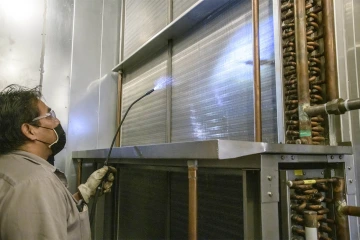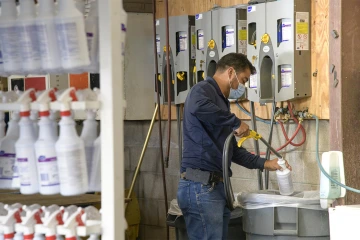Facilities Battles COVID-19 in the Air and on the Ground
From MERV 13 filters to an Oxivir disinfectant station, Facilities Management has made significant changes to mitigate the spread of COVID-19 on campus.

The University of Arizona Facilities Management team and key university stakeholders have worked diligently since spring 2020 to mitigate COVID-19 exposure for all students, staff and faculty. Pictured here, Facilities Management HVAC mechanics Sandra Acuna and Edward Leon install a new MERV 13 filter in the Health Sciences Innovation Building (HSIB).
As students return to the University of Arizona Health Sciences campuses in the midst of the rapidly spreading Omicron variant, a group that largely works behind the scenes is carefully watching to make sure the buildings are as healthy and safe as possible.

A new MERV 13 filter before installation.
Kopach said the key to staying ahead of the game was “Communication, communication, communication. Our entire team worked to create a safe environment throughout our campuses. How did we measure that? We didn’t see huge spreads of COVID. Yes, we had some cases, but they were predominantly coming from outside back onto campus, so we addressed that by going ahead and cleaning.”
Kopach said there were numerous daily and weekly meetings with key university stakeholders including the ICS team; UArizona President Robert C. Robbins, MD; Health Sciences Senior Vice President Michael D. Dake, MD; Senior Vice President for Academic Affairs and Provost Liesl Folks, PhD; laureate professor in the Mel and Enid Zuckerman College of Public Health and 17th Surgeon General of the United States, Richard Carmona MD, MPH, FACS, and many other Health Sciences faculty members from across the five colleges. Facilities Management staff, including custodial staff and building managers, also attended daily and weekly Zoom meetings to keep everyone informed.
Recently Kopach and College of Public Health professor and Public Health Advisory Coronavirus Team (PHACT) member Paloma Beamer, PhD, described some of the steps taken to protect people in university buildings from COVID-19, as well as the science and research behind these efforts.
“Our entire team worked to create a safe environment throughout our campuses.”
Chris Kopach, associate vice president and incident command system (ICS) commander
“Ultimately, what we're talking about is the probability of infection risk,” said Dr. Beamer. “So really we're thinking about how often you're exposed to the virus, potentially at what concentration levels and for how long. So to minimize risk, we're trying to reduce all three of these areas.”
The Facilities Management team instituted several engineering controls to reduce the spread of the SARS-CoV-2 virus, which can spread through droplets, aerosols and airborne transmission. Improving HVAC filters, increasing air flow from outside and installing portable air cleaners in certain areas have been some of the team’s priorities.
As Kopach noted, air filters are typically rated on a Minimum Efficiency Reporting Value, or MERV, scale from one (the lowest) to 20 (the highest). “We went from sevens and eights – think of your home filters that are filtering out dust, particles, dander and so forth – and increased it to 13 so we could be even more efficient in filtering out particles that could possibly contain the COVID virus,” Kopach said.
For Health Sciences buildings in particular, this means that every building is using MERV 13 filters, which are being changed regularly. Dr. Beamer added that the MERV 13 filters remove around 95% of aerosols bigger than one micron in diameter, which is an improvement over the MERV 8 filters that UArizona buildings used to have, which remove only 75% of aerosols of that size. Across the entire campus, 8,000 MERV 13 filters – close to 100% of all systems – have been installed.

Chilled or hot water travels through coils inside the air handler unit to either cool or heat spaces within buildings. General maintenance mechanic Leander Wagner sprays disinfectant cleaner on the coils to mitigate the spread of COVID-19.
Kopach said every building on campus now has access to carbon dioxide (CO2) monitors that can be checked out from the building manager to monitor the amount of CO2 emissions in classrooms and meeting rooms. The monitors let instructors, students or staff know if the CO2 levels are getting too high in a room and they can then decide to take a break or open a door to increase air flow.
Dry air scrubbers pull air through a series of filters including a high efficiency particulate air (HEPA) filter and push out “clean” air. Several of these air scrubbers were installed in areas that would typically have large groups of people in enclosed spaces, like the food court in the Student Union on the main Tucson campus or in classrooms with air exchange rates below a safe threshold.
Enhanced cleaning including disinfectant is another mitigation technique Facilities Management continues to perform. Custodial staff are trained on COVID isolation, cleaning techniques and how to correctly wear personal protective equipment (PPE).
Dr. Beamer pointed out, “We know that all exposures to virus can be controlled to some degree and by some method, but each individual control may not completely control that exposure, and that more than one control may be useful or required. Really, it's when we use multiple controls simultaneously that we're increasing the overall effectiveness and minimizing risk and preventing infection.”
In preparing campus for near-normal operations, Facilities Management has installed 2,000 sneeze guards, 1,530 wall-mounted hand sanitizer dispensers, 2,350 touch-free paper towel dispensers and 1,310 toilet seat covers. They established isolation dorms and student isolation transportation. They created a disinfecting station where thousands of bottles of Oxivir disinfectant, which kills the SARS-CoV-2 virus, is filled and replaced across campus; and they have centralized PPE purchasing and storage for the entire campus.

Grounds crew chief Humberto Sarabia-Fulgencio refills a bottle of Oxivir disinfectant in Facilities Management’s converted Small Engine Shop, now a disinfectant station. The station refills thousands of bottles of disinfectant to share across the campuses.
“From the facilities management team, to incident command, the President’s Office, Dr. Dake and the Health Sciences researchers, we have so many great systems put into place,” Kopach said. “I worked with universities across the country and what we have done to mitigate COVID’s spread has been outstanding.”
Mitigation efforts will be ongoing as more coronavirus variants emerge, and Kopach says his team and colleagues will keep pushing forward. “I hope we never lose the collaboration we developed on this. It has been a critical time in the university’s history, and we saw everybody coming together for the betterment of the university, Pima County and the state of Arizona.”

